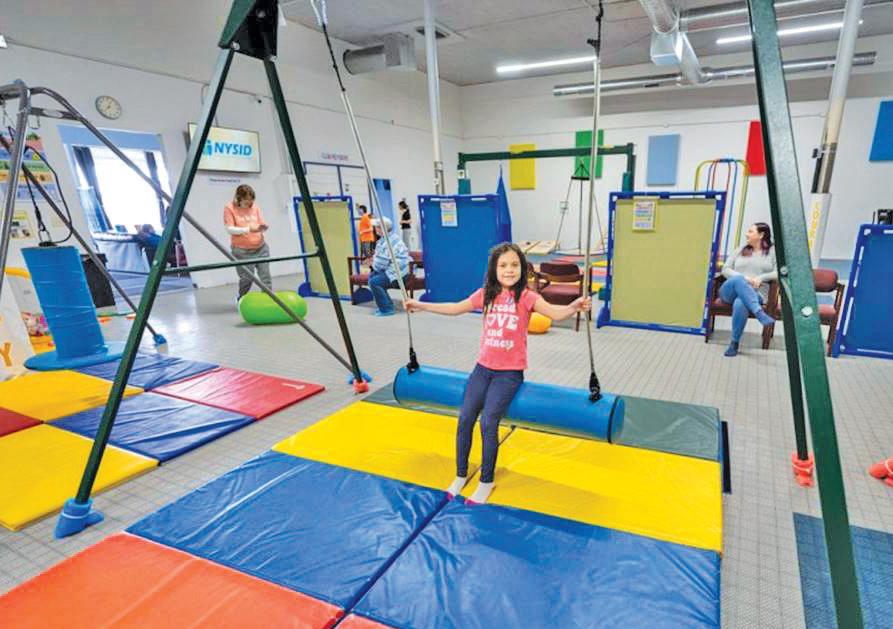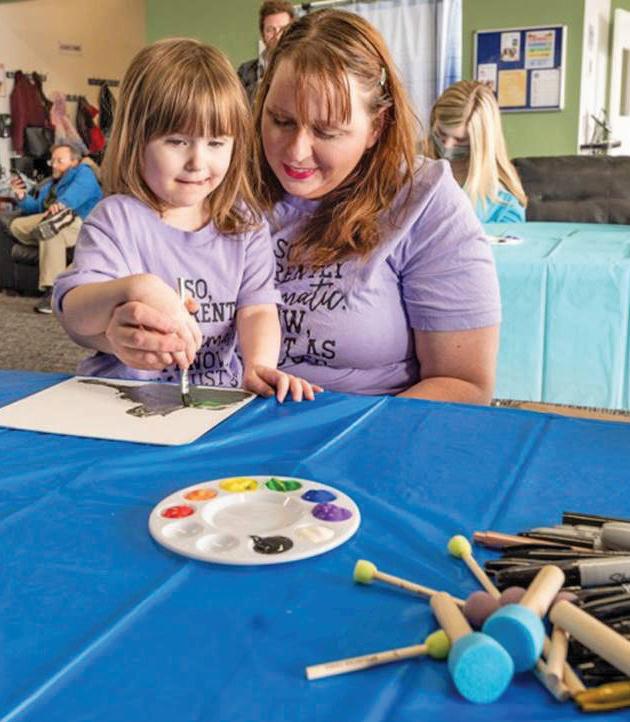
7 minute read
A neurodiverse space
In the Neighborhood An inclusive experience
Bring on the Spectrum in Colonie gives neurodiverse young people and their families a place to be themselves
Advertisement
Everyone needs a place to just hang out and be themselves. For some, that place is harder to find than others.
Bring on the Spectrum, or BOTS, offers that place for those that may not readily fit in with the mainstream.
“I think Lisa’s intention with BOTS is to make it inclusible, which is my word and means ‘suitable for inclusion,’” said Diane Guendel, a special education teacher with the Shenendehowa School District who specializes in using board and other games as a type of therapy. “Too often it is up to our kids to become suitable for inclusion, and I think that is backwards. I think we need to create the spaces and the activities and the opportunities for them, and that is what she has done.”
BOTS is the brainchild of Lisa Audi, who converted a vacant space on Fuller Road into a sensory gym and community center for children and adults who are on the autism spectrum. But “spectrum” here does have a broader definition.
“The word spectrum is in our title and people tend to relate it to autism but we relate it to the spectrum of diagnosis, so it could be any intellectual or developmental disability,” Audi said. “The spectrum of ages that we can have here. Sometimes, when you think of a sensory gym you think of a young kid’s play gym, but this is more than that. This is meant to see the young children through the spectrum of their lives and the spectrum of diversity and inclusion.”
Sensory gyms are not new or unique and include equipment “designed to provide vestibular and proprioceptive input,” according to an article in Autism Parenting Magazine. In other words, the activities in the sensory gym — like swings, slides, air hockey, inner tube trampolines safe climbing apparatus — help with “fine and gross motor skills and improve balance, movement and spatial orientation.”
“There isn’t anything else like it where we can bring them. There are outdoor playgrounds but when the weather is [bad], the couch becomes the bouncy tire and there is nowhere else to take them,” said Lisa Shapiro, who was watching her 13-yearold son Jacob enjoying a swing. “There are gyms for us, adults have places to go, but there isn’t anywhere for kids, especially kids on the spectrum, where he can be loud or stimming and it’s OK and that’s the key thing. Everyone is welcome.”
“It’s great so far. It is somewhere we can go and get out of the house for a little while and she loves it,” said Melissa Angeles as she watched her daughter Selena play on a swing set. “There isn’t much around for them. There is Dave and Busters but it’s too busy and too crazy and too crowded with kids and this place is a little more low-key and it’s better for her.”
More than a gym
There were sensory gyms in Ballston Spa and Latham but both closed, so Audi saw a need. Her vision, though, was to offer more than a sensory gym, and the space on Fuller Road also includes a large community room that plays host to programs like art and yoga classes, and there is a mom who is a beautician and wants to start a hair styling and make up class.
“I said ‘great.’ We are open to all ideas. This is not my community space. It is the community’s
space. If people have ideas, like mom the hair dresser, we want to hear them,” she said. “When we were out blossoming this idea, we wanted it to be more than a sensory gym and that is where the idea for the community space came about, to include social, recreational and lifestyle activities and that can be anything from art to yoga to Zumba. Really to anything.” by On Sunday, Guendel was hosting board games in the com-
Jim munity room and Emily Barbara was teaching an art class, instructFranco ing children and adults on how to paint a rainbow arched over grassy, green hills. The space on Fuller Road has a number of smaller rooms as well including a “sensory room,” which is darkened and has different lights and stimulus where children can go if they do get over stimulated by the activities “It’s a place where you can calm yourself when you get a little over stimulated and we are very appreciative of Price Chopper’s Golub Foundation for sponsoring it,” Audi said. BOTS does not get any direct governmental funding but some families are able to access fees through the state Office for People with Developmental Disabilities.
RIGHT: Lisa and Carabelle Audi at BOTS.
FAR RIGHT: Diane Guendel, (center) a special education teacher with the Shenendehowa School District, plays a board game at BOTS
PHOTOS By JIm FRANCO



ABOVE: Persephone and Sara Kromrey take an art class at BOTS.
LEFT: Salena Angeles rides on a swing at BOTS.
PHOTOS By JIm FRANCO
Audi said they are exploring grant opportunities and she is working with the surrounding school districts. The Shaker High School Pathways in Technology students built the acoustic panels for the sensory gym, which were a necessity because with the large, open space needed for the gym comes unpleasant echoes and sounds that can be disturbing to anyone, and more so for the children who frequent the gym.
Families pay for the different classes offered by BOTS at the community room or for time in the sensory gym or any of the other rooms and activities it offers. So far, Audi said, they are seeing up to 50 “customers” a day since having a soft opening last month but it has been a slow opening by design.
“Our population needs to be comfortable coming some place,” Audi said. “We didn’t want it to be a negative experience, or a one and done, and that could have happened if they were overwhelmed so we are keeping our numbers down because it is all about making sure they have a positive experience and that they are comfortable coming back.” Why not me
COVID had negative effects in so many ways, and when the pandemic hit Audi said she left United Way and was wondering what she was supposed to do with the rest of her life. Nine years ago she adopted a daughter, Carabelle, who is on the spectrum, and saw friends in the autism community struggle to find a place to take their children.
“Everyone talks about a career pivot during COVID and I was trying to figure out what to do next and we saw this opportunity, myself and fellow board members, and we were stalled by COVID and we thought now was the time,” she said.
The need, too, is irrefutable.
In December, 2021, the U.S. Center for Disease Control said 1 in 44, or 2.3 percent, of 8-yearold children are diagnosed with an autism spectrum disorder based on an analysis of 2018 data. That is up from a previous estimate published in March, 2020, that found 1 in 54, or 1.9 percent of 8-year-old children who were on the spectrum.
COVID also played a role in the decision to open BOTS, Audi said.
“Our population during COVID was probably more ostracized than any other, similar to nursing homes. Folks in residential housing did not have visitors,” she said. “Now as we are coming out of COVID, there is a shortage of workers and direct support professionals so that means some of the day-hab, without walls type programs, are struggling.”
Also, she said, while stressing BOTS is geared to serve more than those with autism, school districts are reporting more students on Individual Education Programs.
Not long ago, she said, while she was watching an art class with students of all ages and there were those who were neurotypical, those who do not have any neurologic diagnoses, painting along with the neurodiverse, those who do.
“There was young people there was old people. It truly was the spectrum of ages and all types and it was a melting pot,” she said. “I took a step back and I said ‘yes, this is what we wanted to create.’”




